Tire vs. Tyre — What's the Difference?
By Urooj Arif & Maham Liaqat — Updated on February 24, 2024
"Tire" is the American English spelling for a rubber covering of a wheel, while "tyre" is used in British English and other Commonwealth nations for the same object.

Difference Between Tire and Tyre
Table of Contents
ADVERTISEMENT
Key Differences
"Tire" refers to the rubber covering that fits around the rim of a wheel in American English, designed to provide traction and bear the vehicle's load. This term encompasses all types of vehicles, including cars, bikes, and trucks, focusing on the American spelling convention. "Tyre," on the other hand, is the preferred spelling in British English and other Commonwealth countries. It carries the same definition, covering a wide range of vehicles, from bicycles to large commercial trucks, but adheres to the British and Commonwealth spelling conventions.
The distinction between "tire" and "tyre" is purely orthographic, with no difference in pronunciation or function. Both terms describe the same essential vehicle component, crucial for safety, performance, and comfort.
"Tire" and "tyre" serve the same purpose in a vehicle's operation, their spelling indicates the version of English being used. This differentiation is particularly noticeable in written communication, such as product descriptions, technical manuals, and marketing materials.
The choice between "tire" and "tyre" does not affect the technical specifications or performance characteristics of the product. Instead, it reflects the linguistic preferences of different English-speaking regions, showcasing the diversity within the English language.
Comparison Chart
Spelling
American English
British and Commonwealth English
ADVERTISEMENT
Usage
Refers to a wheel's rubber covering
Same as "tire," but different spelling
Pronunciation
Same for both terms
Same for both terms
Function
Provides traction and supports load
Identical to "tire"
Linguistic Preference
Used in the United States
Preferred in the UK, Australia, and other Commonwealth countries
Compare with Definitions
Tire
Designed for traction and load-bearing.
Off-road tires have deep treads for better grip.
Tyre
Requires regular maintenance.
Tyre tread depth should be monitored to ensure legality and safety.
Tire
A ring, hoop or band, as of rubber or metal, on the circumference of the wheel of a vehicle, to impart strength and receive the wear. In Britain, spelled tyre.
Tyre
(transitive) To fit tyres to (a vehicle).
Tire
A tire (American English) or tyre (British English) is a ring-shaped component that surrounds a wheel's rim to transfer a vehicle's load from the axle through the wheel to the ground and to provide traction on the surface over which the wheel travels. Most tires, such as those for automobiles and bicycles, are pneumatically inflated structures, which also provide a flexible cushion that absorbs shock as the tire rolls over rough features on the surface.
Tyre
Provides grip and carries weight.
Racing tyres are specially designed for high-speed performance.
Tire
A covering for a wheel, usually made of rubber reinforced with cords of nylon, fiberglass, or other material and filled with compressed air.
Tyre
Crucial for driving performance.
Low-profile tyres can enhance handling but may affect comfort.
Tire
(American spelling) tyre#Etymology 1: The metal rim of a wheel, especially that of a railroad locomotive.
Tyre
The metal#Adjective rim, or metal covering on a rim, of a (wooden or metal) wheel, usually of steel or formerly wrought iron, as found on (horse-drawn or railway) carriages and wagons and on locomotives.
Iron tyres for the coach and iron shoes for the horse
Tyres and rails of steel, and every axle with roller bearings
Tire
Hoop that covers a wheel;
Automobile tires are usually made of rubber and filled with compressed air
Tyre
Hoop that covers a wheel;
Automobile tires are usually made of rubber and filled with compressed air
Tire
Essential for vehicle safety.
Worn tires can significantly increase the risk of accidents.
Tyre
British spelling for a wheel's rubber covering.
The lorry had its tyres checked before the trip.
Tire
Alternative spelling of tyre#Etymology 1: The rubber covering on a wheel.
Tyre
Comes in multiple forms.
Tubeless tyres are popular for their puncture resistance.
Tire
A rubber covering for wheels.
The car needs its tires rotated every 5,000 miles.
Tyre
The ring-shaped protective covering around a wheel which is usually made of rubber or plastic composite and is either pneumatic or solid.
Pneumatic tyres
Runflat tyres
Tire
Subject to wear and tear.
Checking tire pressure regularly helps prevent premature wear.
Tire
Available in various types.
Snow tires are recommended for winter driving conditions.
Common Curiosities
Does the spelling change affect how tires/tyres are made?
No, the manufacturing process and technology are the same, regardless of spelling.
Is "tyre" accepted in international contexts?
Yes, "tyre" is widely understood and accepted in English-speaking countries outside the US.
Are there any other differences between "tire" and "tyre" besides spelling?
No, the terms are functionally and semantically identical, differing only in regional spelling.
Is there a difference in quality between "tire" and "tyre"?
No, the difference is purely spelling; quality depends on the manufacturer and model, not the spelling.
Why do British English and American English use different spellings?
The variations developed over time due to historical linguistic evolutions and preferences.
Are "tire" and "tyre" pronounced differently?
No, they are pronounced the same in both American and British English.
How should I spell it if writing for a global audience?
Consider your target audience or use the spelling of the English variant you are most comfortable with.
How can I remember which spelling to use?
Consider the audience or region you're writing for: "tire" for American readers and "tyre" for British or Commonwealth audiences.
Do "tire" and "tyre" have the same plural form?
Yes, the plural forms are "tires" in American English and "tyres" in British English.
Do automotive companies use both spellings?
Yes, companies adjust their spelling based on the market they are addressing.
Can using the wrong spelling impact search engine optimization (SEO)?
Potentially, as search queries may be region-specific. It's wise to use the spelling that matches your target audience's preference.
Are there any legal implications of the spelling in technical documents?
No, but using the regionally appropriate spelling can improve the document's readability and professionalism.
Can I use "tyre" in American English?
While understandable, it's non-standard and "tire" is the preferred spelling in American English.
Has the spelling difference led to any significant misunderstandings?
Not typically, as the context usually makes the meaning clear, regardless of the spelling used.
Do English language exams differentiate between "tire" and "tyre"?
Exams typically accept both spellings, but it's important to consistently use one form based on the English variant of the exam.
Share Your Discovery

Previous Comparison
Consideration vs. Respect
Next Comparison
Disseminate vs. DisperseAuthor Spotlight
Written by
Urooj ArifUrooj is a skilled content writer at Ask Difference, known for her exceptional ability to simplify complex topics into engaging and informative content. With a passion for research and a flair for clear, concise writing, she consistently delivers articles that resonate with our diverse audience.
Co-written by
Maham Liaqat















































